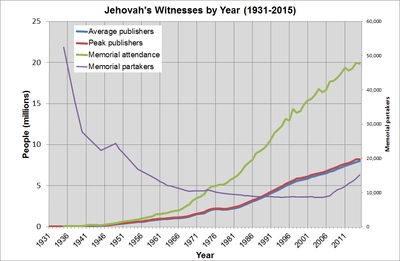WIKIPEDIA:
Church membership in 2013 was 1.254 billion, which is 17.7% of the world population,[4] an increase from 437 million in 1950[72] and 654 million in 1970.[73] Since 2010, the rate of increase was 1.5% with a 2.3% increase in Africa and a 0.3% increase in the Americas and Europe. 48.8% of Catholics live in the Americas, 23.5% in Europe, 16.0% in Africa, 10.9% in Asia and 0.8% in Oceania.[74] Catholics represent about half of all Christians.[75]
In 2011, the Catholic Church had 413,418 priests. The main growth areas have been Asia and Africa, with 39% and 32% increases respectively since 2000, while the numbers were steady in the Americas and dropped by 9% in Europe.[74] In 2006, members of consecrated life totalled 945,210; 743,200 of whom were female.[76] As of 2009 there were approximately 5,100 bishops total in the Latin and Eastern churches.[77]
Jehovah's Witnesses have an active presence in most countries, but do not form a large part of the population of any country.
As of August 2015, Jehovah's Witnesses report an average of 8.2 million publishers—the term they use for members actively involved in preaching—in 118,016 congregations.[2] In 2015, these reports indicated over 1.93 billion hours spent in preaching and "Bible study" activity. Since the mid-1990s, the number of peak publishers has increased from 4.5 million to 8.2 million.[284] In the same year, they conducted "Bible studies" with over 9.7 million individuals, including those conducted by Witness parents with their children.[4][285][286] Jehovah's Witnesses estimate their current worldwide growth rate to be 1.5% per year.[2]
The official published membership statistics, such as those mentioned above, include only those who submit reports for their personal ministry; official statistics do not include inactive and disfellowshipped individuals or others who might attend their meetings. As a result, only about half of those who self-identified as Jehovah's Witnesses in independent demographic studies are considered active by the faith itself.[287][288] The 2008 US Pew Forum on Religion & Public Life survey found a low retention rate among members of the religion: about 37% of people raised in the religion continued to identify themselves as Jehovah's Witnesses.[289][290]

